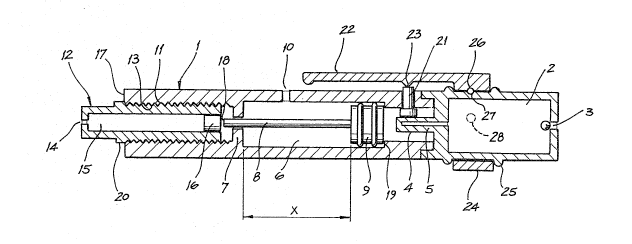Note: Claims are shown in the official language in which they were submitted.
The embodiments of the invention in which an exclusive property or
privilege is claimed are defined as follows:
1. A device for introducing a liquid into a patient, including:
a capsule for containing the liquid, the capsule including a
hollow body with a nozzle end through which the liquid exits from within
the capsule, and a capsule piston movably mounted within the body and
operable to push the liquid out through said nozzle end;
a body providing a reservoir for receiving a quantity of gas
under pressure from a gas source;
an interacting actuator piston and cylinder assembly, within
the body, providing a variable volume space behind the actuator piston;
a neck, having a closed end, extending from said reservoir to
said space behind the actuator piston;
means operable by a user to open said closed end to permit
said quantity of gas to pass from said reservoir to said space behind the
actuator piston to cause movement of said actuator piston within said
cylinder;
a piston rod extending from said actuator piston towards an
anterior end of the body and engageable with the said capsule piston to
cause movement thereof upon said quantity of gas under pressure being
delivered to said space behind the actuator piston;
a capsule mounting means, at the anterior end of the body, to
connect the capsule to the body while allowing the capsule to be axially
moveable along the anterior end so that the distance between the capsule
piston and a front end of the piston rod can be varied so that the amount
of penetration of the piston rod into the capsule, upon movement of the
actuator piston, may be adjusted to vary the amount of liquid expelled
from the capsule.
2. The device of claim 1 wherein said mounting means includes a
threaded recess at the anterior end of the body, and external threads on
the capsule that are received within said recess, so that rotation of the
capsule axially moves the capsule along the anterior end of the body to
adjust the position of he capsule.
3. The device of claim 2 wherein the mounting means further
comprises detent means for engaging the capsule.
4. A device for introducing a liquid into a patient, including:
a capsule for containing the liquid, the capsule includes a
hollow body with a nozzle end through which the liquid exits from the
capsule, and a capsule piston movably mounted within the body and
operable to push the liquid out through said nozzle end;
a body providing a reservoir for receiving a quantity of gas
under pressure;
an interacting actuator piston and cylinder assembly, within
the body, providing a variable volume space behind the actuator piston;
a frangible neck extending from said reservoir into said space
behind the actuator piston;
means operable by a user to break said frangible neck to
permit sad gas to pass from said reservoir to said space behind the
actuator piston to cause movement of said actuator piston within said
cylinder;
a piston rod extending from said actuator piston towards an
anterior end of the body and engageable with the said capsule piston to
cause movement thereof upon said quantity of gas under pressure being
delivered to said space behind the actuator piston; and
a capsule mounting means, at the anterior end of the body, to
connect the capsule to the body while allowing the capsule to be axially
moveable along the anterior end so that the distance between the capsule
piston and a front end of the piston rod can be varied so that the amount
of penetration of the piston rod into the capsule, upon movement of the
actuator piston, may be adjusted to vary the amount of liquid expelled
from the capsule.
5. The device of claim 4 wherein said neck includes a weak
section, said neck being fracturable and wherein said device further
includes trigger means operable by a user to fracture sand neck.
6. The device of claim 4 wherein said cylinder and mounting means
are integrally formed, said mounting means is internally threaded at the
anterior end of the body, and wherein external threads on the capsule are
received within said recess so that notation of the capsule axially moves
the capsule along the anterior end of the body to adjust the position of
the capsule.
7. The device of claim 6 wherein said mounting means includes
detent means for engaging the capsule.
8. The device of claim 4, wherein the means openable by a user to
break said frangible neck further comprises a plunger which extends
radially through the body adjacent the frangible neck.
9. The device of claim 8 further comprising a ring rotatably
mounted on the body, the ring supporting an arm which is positionable
over the plunder for facilitating activation of the plunger.
